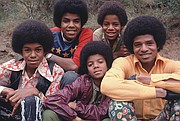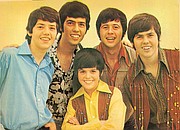Pop music history: 1970, a pivotal year
The first year of the 1970s could be viewed as a pivotal year for several different developments in popular music. It was the year The Beatles officially broke up, marking the end of a truly remarkable era in music.
It was also a year when the world lost three rising stars while they were at the height of their popularity, each of them being only 27 when they died. The revolutionary rock guitarist Jimi Hendrix, and also Alan Wilson (lead singer for the band Canned Heat) both died in September, and singer Janis Joplin died in October, just over three months before her version of Kris Kristofferson’s “Me and Bobby McGee” was posthumously released, ultimately topping the Billboard Hot 100 chart in early 1971.
The first year of the 70s also brought back the already proven successful formula of a made-for-television pop group with a new musical sitcom, The Partridge Family, which ran from September 1970 until March 1974. The show’s fictional family that performed music together as a band and traveled around in a custom-painted school bus was based loosely on the real-life musical family from Rhode Island, the Cowsills, who are best remembered for their three hits: “The Rain, The Park, & Other Things” from 1967 and “Hair” from 1969, both songs reaching No. 2 on Billboard’s Hot 100, and “Indian Lake” from 1968, which reached No. 10.
The Partridge Family starred Shirley Jones and David Cassidy, son of actor Jack Cassidy. Shirley Jones, who was married to Jack Cassidy, played Mrs. Partridge and David’s character, Keith Partridge’s mother on the show while in real life she was his stepmother. The initial success of the show yielded a real-life number one hit, “I Think I Love You” (written by Tony Romeo who also wrote “Indian Lake” for the Cowsills), which topped Billboard’s Hot 100 in November 1970.
Musical families weren’t just popular in fictional TV shows at the start of the 70s, but in real life as well. The youthful brothers from Gary, Indiana performing and recording as The Jackson Five were the first group in history to see their first four singles reach the top of the Hot 100, all in the year 1970: “I Want You Back,” Jan. 31; “ABC,” April 25; “The Love You Save,” June 27; and “I’ll Be There,” Oct. 17.
And the Osmond Brothers from Utah who had been in the spotlight periodically since 1963, with multiple appearances on the Andy Williams Show, and by this time performing as The Osmonds, released “One Bad Apple” in November 1970, which eventually topped the Hot 100 in February of ‘71.
Groups featuring siblings continued to find popularity within different genres, including the Allman Brothers, Creedence Clearwater Revival, and the Cornelius Brothers & Sister Rose. Brother-sister duo Richard and Karen Carpenter performing as the Carpenters saw their recording of the Burt Bacharach and Hal David song, “(They Long to Be) Close to You” reach the top of the Billboard chart in July 1970, and the Gibb brothers who had just regrouped their Bee Gees band were soon to reach the No. 1 position with their “How Can You Mend a Broken Heart” in August of ‘71.
Although the seeds of a new and radical variation of rock music that would eventually be labeled “heavy metal” had been sown in the late 1960s by such recording artists as Iron Butterfly, the Crazy World of Arthur Brown, Blue Cheer, Led Zeppelin, and even The Beatles with their 1968 White Album and its famous screamer “Helter Skelter,” 1970 was perhaps the year heavy metal music began to really germinate and become a thing. The so-called “unholy trinity of British heavy metal rock groups” Deep Purple, Led Zeppelin and Black Sabbath each released notable albums in this new rock genre typified by loud and dramatic vocals, plenty of minor chords to create the darker moods, and heavily distorted electric guitars. They paved the way for the multitudes of hard rockers who followed throughout the next several decades.
From 1970 onward music continued to branch out in widely different directions, to an extent like it had been doing already in the 1960s, but even more so. The folk-rock duo Simon & Garfunkel released the most successful song of their careers in 1970 with “Bridge Over Troubled Water,” which climbed to the top of the Hot 100 at the end of February and remained there for six weeks. And both folk and country music continued to cross over into other genres.
The year 1970 could also be viewed as the beginning of a kind of Dutch invasion, when music groups from the Netherlands first began to enjoy considerable success in North America. Shocking Blue reached the No. 1 position on the Hot 100 with their song, “Venus” (not to be confused with an earlier and very different song with the same title by Frankie Avalon), and a song by the Dutch band, Tee Set, “Ma Belle Amie” reached No. 5. The George Baker Selection had a hit with “Little Green Bag” in 1970 and six years later they would have an even bigger hit with “Paloma Blanca.” Between 1970 and 1979 a number of other Dutch artists rose to international fame, including, among others, Earth and Fire with “Seasons” in 1970, The Cats with “One Way Wind” in 1971, Mouth and MacNeal with “How Do You Do” in 1972, and Golden Earring with “Radar Love” in 1973.
And so began the decade that would bring us programmable drum machines and polyphonic synthesizers, various new trends in music from punk rock and new wave and eventually a unique new rock guitar style introduced by Van Halen’s lead guitarist, Eddie Van Halen in the late 70s, to the relatively short-lived disco craze, as well as a myriad of other new sounds and musical innovations.









